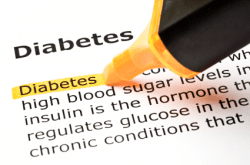The term ‘diabetes’ means excessive urination and the word ‘mellitus’ means honey.
Diabetes mellitus is a lifelong condition caused by a lack, or insufficiency of insulin. Insulin is a hormone – a substance of vital importance that is made by your pancreas. Insulin acts like a key to open the doors into your cells, letting sugar (glucose) in. In diabetes, the pancreas makes too little insulin to enable all the sugar in your blood to get into your muscle and other cells to produce energy. If sugar can’t get into the cells to be used, it builds up in the bloodstream. Therefore, diabetes is characterized by high blood sugar (glucose) levels.
Before you got diabetes
Before you got diabetes, your body automatically kept your blood sugar exactly at the right level. Here is how that worked. After a meal containing carbohydrates, sugar is absorbed into the blood stream very quickly. The amount of sugar in your blood must not get too high or too low. Two hormones – insulin and glucagon – were produced in the pancreas – to ensure that the blood sugar was always well controlled no matter how much you had to eat and how much you exercised.
Types of diabetes
Diabetes Mellitus is the most common and there is two different categories:
Type 1 diabetes tends to occur in childhood or early adult life, and always requires treatment with insulin injections. It is caused by the body’s own immune system destroying the insulin-making cells (beta-cells) of the pancreas.
Type 2 diabetes usually develops slowly in adulthood. It is progressive and can sometimes be treated with diet and exercise, but more often Type 2 diabetes may require antidiabetic medicine and/or insulin injections.
Prediabetes is described in this video clip –
Diabetes Insipidus is often confused with diabetes mellitus because of the similar name and symptoms. Diabetes insipidus is a rare disorder where the system the body uses to regulate its water levels becomes disrupted. More information can be found here. To contact the Irish support group see https://www.pituitary.org.uk/support-for-you/support-in-your-area/ireland/republic-of-ireland/
The differences between type 1 diabetes and type 2 diabetes
| Characteristics of the condition | Type 1 Diabetes | Type 2 Diabetes |
|---|---|---|
| Risk Factors - Very different | • Having another autoimmune condition • Having a parent or sibling with type 1 diabetes combined with environmental factors and a common infection which may trigger onset | • Over 40 years of age • Have a parent or brother/sister with diabetes • Had diabetes during a pregnancy • Are overweight for your height • Do not take 30 minutes of physical activity daily • Have high blood pressure and/or high cholesterol |
| Symptoms: Some overlap | Fast onset of extremely high blood glucose levels which leads to: • Extreme thirst • Frequent urination • Weight loss • Hunger • Fatigue | High blood glucose levels which lead to: • Thirst and frequent urination • Urinary tract infections • High blood pressure • Fatigue • Neuropathy • May also have no symptoms or just mild thirst or repeated infections |
| Nature of illness: Very different | Autoimmune condition that causes your cells to kill off your insulin producing beta cells, as a result your body no longer makes insulin. | Your body makes insulin but it isn’t used properly by the body or there is not enough insulin to meet your body’s demands resulting in an insulin inefficiency. |
| Onset: Very different | Quick onset, generally within a few weeks or months. | Slow onset, may be several years after glucose levels begin to rise. On average 12 years pass between onset and diagnosis of type 2 diabetes. |
| Treatment: Some overlap | • Intense daily self-management of insulin to balance food intake or exercise • Must take multiple injections of insulin or infusion through insulin pump | • Daily self-management of food intake, exercise and medication • Over time roughly 40% may need to use insulin injections |
| Age of diagnosis: Typically different | Typically early childhood or adolescence but can occur at any age. | Typically adulthood but can occur at any age. |
| Complications: Same but to varying degrees | • Short term complications give rise to acute emergencies such as hypoglycemia and ketoacidosis • Long term exposure to low glucose levels can cause hypoglycemic unawareness • Long term exposure to high glucose levels can cause blood vessel damage • Blood vessel damage can cause blindness, retinopathy, heart disease and foot problems including amputation and earlier mortality. | • Many people at diagnosis of type 2 diabetes may have already had up to 12 years exposure to long term high blood glucose levels and have complications at diagnosis • Damage to large and small blood vessels throughout the body which causes blindness, retinopathy, heart disease, kidney disease, amputation, gastroparesis, early mortality. |
| Is it preventable?: Very different | No | • Yes, up to 40% of diagnoses may be prevented with healthy diet and weight management • A further 40% may delay the onset of the condition with alterations to dietary intake and healthy activities to curb weight gain. |

